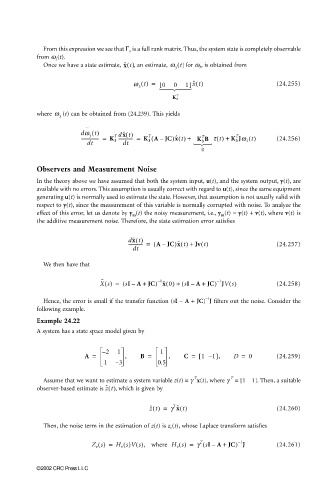Page 796 - The Mechatronics Handbook
P. 796
0066_Frame_C24 Page 44 Thursday, January 10, 2002 3:46 PM
From this expression we see that Γ o is a full rank matrix. Thus, the system state is completely observable
from w 1 (t).
Once we have a state estimate, x ˆ t( ) , an estimate, w t( ) for w 3 , is obtained from
3
w t() = 0 [ 1] x ˆ t() (24.255)
3 0
T
K 3
where w (t) can be obtained from (24.239). This yields
3
ˆ
dw t() T dx ˆ t()
(
T
---------------- = K 3 ------------- = K 3 AJC)x ˆ t() + K 3 B t t() + K 3 Jw 1 t() (24.256)
T
T
3
–
dt dt
0
Observers and Measurement Noise
In the theory above we have assumed that both the system input, u(t), and the system output, y(t), are
available with no errors. This assumption is usually correct with regard to u(t), since the same equipment
generating u(t) is normally used to estimate the state. However, that assumption is not usually valid with
respect to y(t), since the measurement of this variable is normally corrupted with noise. To analyze the
effect of this error, let us denote by y m (t) the noisy measurement, i.e., y m (t) = y(t) + v(t), where v(t) is
the additive measurement noise. Therefore, the state estimation error satisfies
dx ˜ t()
------------- = ( AJC)x ˜ t() + Jv t() (24.257)
–
dt
We then have that
˜
X s() = ( sIA + JC) x ˜ 0() + ( sIA + JC) JVs() (24.258)
–
1
–
1
–
–
−1
Hence, the error is small if the transfer function (sI − A + JC) J filters out the noise. Consider the
following example.
Example 24.22
A system has a state space model given by
A = – 2 1 , B = 1 , C = [ 1 – 1], D = 0 (24.259)
1 – 3 0.5
T T
Assume that we want to estimate a system variable z(t) = g x(t), where g = [1 1]. Then, a suitable
observer-based estimate is z ˆ t() , which is given by
z ˆ t() = g x ˆ t() (24.260)
T
Then, the noise term in the estimation of z(t) is z v (t), whose Laplace transform satisfies
1
–
Z v s() = H v s()Vs(), where H v s() = g sIA + JC) J (24.261)
T
(
–
©2002 CRC Press LLC

